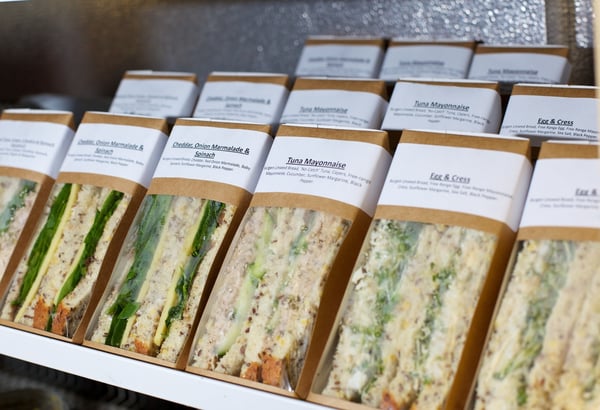Nowadays, a wide range of different labels are available. In addition to various shapes and formats – such as round or rectangular labels with and without rounded corners – an unbelievable amount of different colors are on offer. Labels used in industrial applications are already available in all kinds of colors and printed with an array of motifs. Meanwhile, labels for private use are usually made of paper and are left blank in most cases. These paper labels can then be written on by hand or printed using a standard domestic inkjet or laser printer.
Affixing labels at room temperature
After printing or marking, the labels are then affixed in their intended position. In manual processing – such as in the home – these are usually items that are stored at room temperature. One example of this is removal boxes, which are made of cardboard and are stored in the home in everyday ambient conditions. A paper label attached to the cardboard surface only has to be pressed down firmly for it to remain securely in place.
A similar example is address labels for envelopes. These are either written by hand or printed, then removed from the silicone liner and affixed to the envelope.
In industry, labels for logistics applications are also applied at room temperature.
General purpose adhesives – suitable for use at room temperature – are used here. The formulation of these adhesives means they have to be affixed at temperatures above +10 °C. Below this temperature, the initial tack of the adhesive is insufficient to achieve a suitable bond on the corresponding surface. Once they have been affixed and their final adhesive bond has been reached after 24 hours, these labels remain securely attached to the surface when kept at temperatures ranging from around -10 °C to around +70 °C.

Semi-deep-freeze adhesives for applications at temperatures as low as -5 °C
However, not all applications are set up for labeling at +10 °C and above. In industrial applications, temperatures in unheated halls can fall below +10 °C in winter months. General purpose adhesives are too hard in such cases, meaning they can no longer achieve a suitable bond on the corresponding surface. In such situations, a softer adhesive formulation is required. These are often called semi-deep-freeze adhesives. Thanks to their special formulation, they are soft enough to achieve a good initial tack at temperatures as low as -5 °C. Labels with semi-deep-freeze adhesives can then be used for labeling plastic containers stored in the refrigerator, for example.
As these adhesives have an excellent initial tack, they are also often repurposed for applications at room temperature – such as on rough cardboard, for example. Here, the adhesives can also demonstrate their excellent adhesive qualities.
Labeling at -25 °C with deep-freeze adhesives
Foodstuffs such as meat and sausages are frozen for storage as they would otherwise spoil quickly. As these products also have to be marked accordingly, labels are also used here. However, the storage temperatures are significantly below -5 °C – freezers in the home have a temperature of -18 °C – which means semi-deep-freeze adhesives cannot be used here. An even softer adhesive is required here so that the labels also achieve a sufficient bond at temperatures as low as -25 °C. Sometimes, the surface to be labeled also has a fine layer of condensation, which makes labeling even more difficult.
.jpg?width=600&name=Nur%20f%C3%BCr%20redaktionelle%20Zwecke%20(Blog%20%26%20Website).jpg)
Deep-freeze adhesives are available for such applications. These achieve a good bond at temperatures as low as -25 °C – including on slightly moist surfaces. These adhesives are very aggressive and tacky. As they achieve a rapid bond with the surface, labels are manufactured in this way for use on high-speed labelers. One to two labels are dispensed per second. In some cases, labels are no longer applied using pressure, but are instead blown onto the surface by an air jet. The labels must achieve a secure bond with the surface and must not become detached. This poses some significant challenges in terms of the adhesive.
Deep-freeze adhesives are so soft that they can be used at temperatures between -40 °C and +40 °C. However, the adhesive bond at room temperature is not particularly high.
Nonetheless, this characteristic also allows them to be used in applications where the label has to be removed after carrying out its function.
Different applications for deep-freeze adhesives
Deep-freeze adhesives are thus also a popular choice where easily detachable labels are required.
Applications at low temperatures continue to be dominated by hot melts.
Dispersion adhesives can also be used for applications at room temperature. While the focus remains on hot melts when it comes to semi-deep-freeze adhesives, dispersion adhesives have made some major advances and are also seen in certain semi-deep-freeze applications.
Adhesives for temperatures as low as -200 °C
Additionally, there are also applications in the medical field where significantly lower storage temperatures of as low as -200 °C are the norm. Of course, samples that are stored in ampules or test tubes and cooled with nitrogen have to be clearly labeled and identifiable. Labels for such applications use special cryogenic adhesives containing acrylate. Labeling is often made at room temperature here, after which cooling takes place.
Summary
To summarize:
- Products are labeled at different temperatures
- After labeling, products are stored at different temperatures
- Users must choose between general purpose adhesives, semi-deep-freeze adhesives, deep-freeze adhesives or cryogenic adhesives
- The appropriate adhesive must be selected according to the applicable temperature range